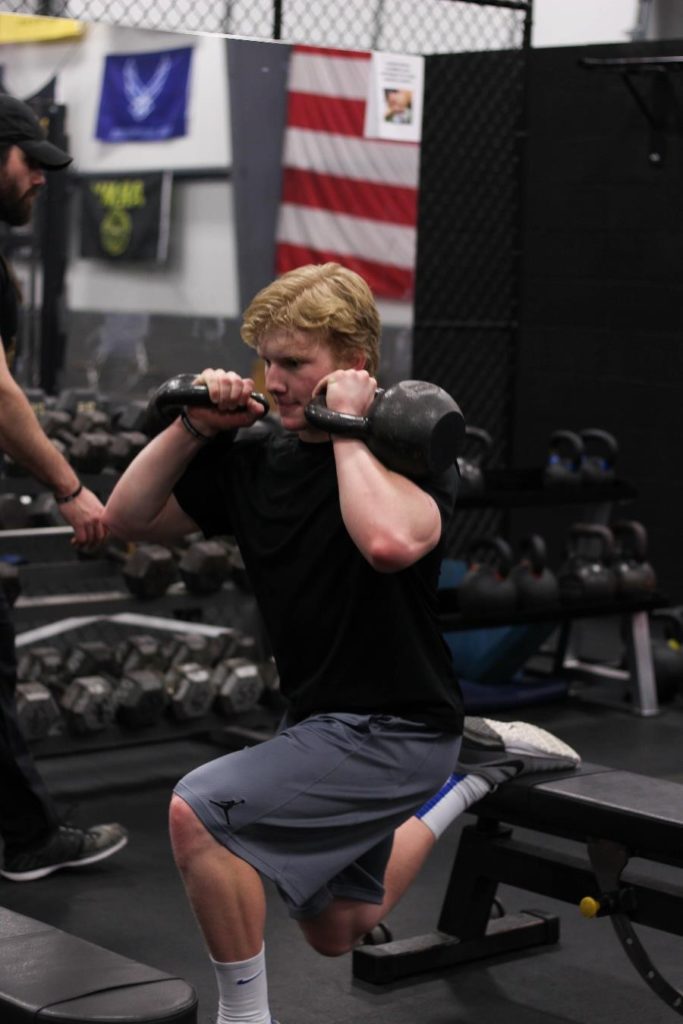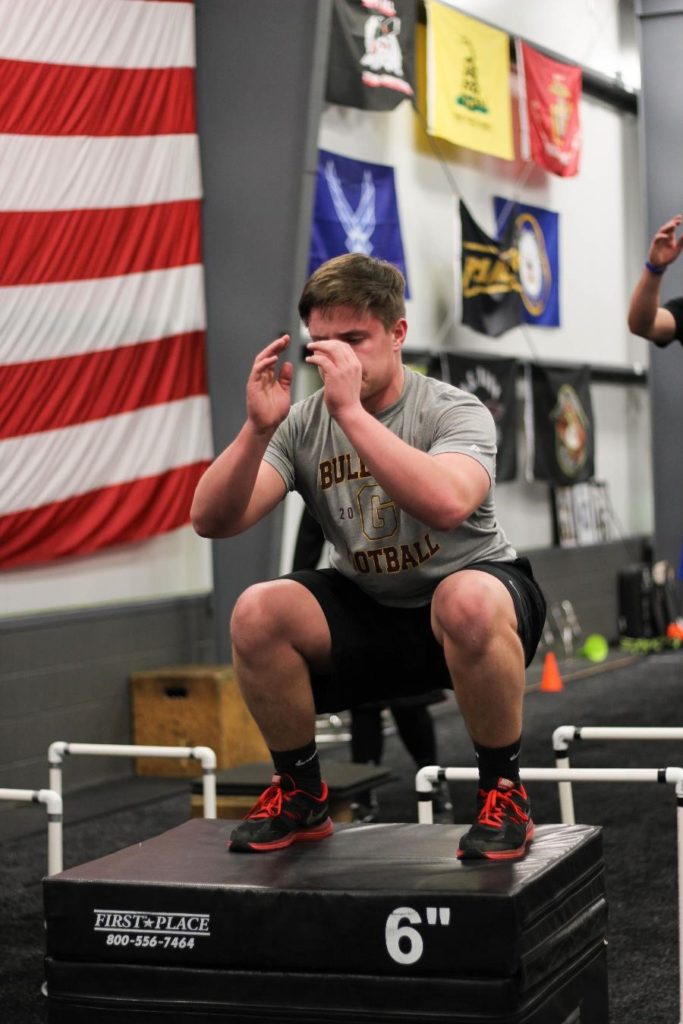Blog
Top 5 Keys for Training During the Football Season
As many of our football athletes are about to begin post-season play, we are reminded of the importance of In-Season training. It has been a common topic of conversation and one I wanted to dive into further. Many of the principles translate to other sports as well.
Training properly throughout the football season will keep athletes stronger, faster, and healthier longer than their competition. Early in the season it’s easy to discount the impact of training correctly, but by week 6 or 7 the lull starts to set in and the value of maintaining or improving athletic qualities is clearly demonstrated. Getting hyped for playoff games clears some of the mental funk, but how many players are performing below their maximal output and nursing nagging injuries at the end of the season?
On a year-long and career-long scale, we see that in-season training is incredibly important to our football athletes’ development. Not only does improper training lead to decreased performance in competition, it also serves to dig a deeper hole for the athlete for what they do next. Whether it’s another sport or training for next season, athletes who are under-recovered and nursing nagging injuries need more time to recuperate after the season. Those who train correctly throughout the season have the opportunity to resume training or begin another sport sooner and safer after football is over. Athletes can retain more performance throughout the season and go back to increasing their performance more quickly after competition ends. In a year-long and career-long model of athlete development, in-season training is one of the greatest investments that coaches can make.
We’ve seen many, many different approaches to in-season training used at every possible level of football. We work with athletes who don’t train at all in-season and we work with athletes who train high volume 2 or 3 times per game week. Our program is supplementary to what they’re doing with their teams. The wide range of in-season training variables can create programs that are too much, too little, too different, too similar, or any other shade of less than perfect.
In order to work towards a solution for the less-than-optimal in-season program, I’d like to highlight the principles that we use to construct a successful in-season training program.

1. Motion is Lotion
At the very least in-season training should seek to retain movement capabilities for athletes who would like to avoid injury. The game of football is highly varied and each position has different demands, but everyone on that field should be able to move like a human. Too often in-season programs compress (or discard) the soft tissue care, mobility, and warmup portions of training in the interest of time. Many, many of the nagging injuries we see throughout the season are the result of compromised movement patterns and/or unbalanced overuse of structures. Those who retain their ability to move correctly throughout the season have the capability to spread the stress of this highly physical game to more tissues. Those who retain their ability to move correctly also provide themselves more “options” should they be forced into a compromised position and are less likely to be injured.
We have all of our in-season athletes perform their full off-season regimen of soft tissue work, mobility, and warmup drills each time they train. In addition, we add active mobility (“resets”) throughout the weights portion of their training as active rest. Athletes are continuously assessed and are asked to communicate any nagging injuries or anything that doesn’t feel right. If a problem comes up, we change the movements in the workout to accommodate less stressful positions and add more directed mobility/soft tissue work to help the issue.
2. Strength is King
While many athletic qualities should be trained and hopefully retained throughout the season, football athletes need strength above all else. Skill players need more speed-strength (strength with a component of speed) while bigs need more absolute strength. Strength forms the basis of speed, power, size, quality of movement, and resiliency. This doesn’t mean, however, that football players should be asked to transform into powerlifters. Finding ways to expose athletes to heavier loads in a safe (neurologically and physically) manner is of utmost importance.
We change the loads and movements for our in-season athletes based on their readiness to train. This is based on their body language, their honest feedback on how they feel, their movement quality, and the demands of their competition schedule. Then we tell them to operate at 80% of what they could do for a given set, and we keep the reps low. We have found those loading and volume parameters generally lead to enough work to retain and develop strength without putting the athlete in a compromised state.
We use implements and movements that provide the greatest stimulus at the lowest cost. That may be a safety squat bar to save a quarterback’s shoulders from the beating of squatting with a regular bar. It may be performing concentric-only trap bar deadlift drops to eliminate the most demanding (the eccentric) portion of the lift. Or it may be telling our athletes to perform clean high pulls instead of full cleans with a catch to spare their wrists, elbows, and shoulders. Whatever the accommodation is, we continuously look for the biggest bang for our buck so we can help our athletes progress at the lowest possible cost. We want our football players to spend their capacity on the field, not in the weight room.
3. Variation Can be Good and Bad
The body sees all new demands as stress and attempts to adapt to them. This is the entire basis of training, adapting, and overcoming. Keeping variation within controlled bounds is the key to getting enough adaptation while avoiding unnecessary stress. In-season training should not contain movements that are completely foreign because the cost to adapt to those movements outweighs their possible gain. In-season movements should be built off the training principles and movements established throughout the off-season. Small variations, as in the example of high pulls versus full cleans mentioned above, are completely fine and usually lead to better results. On the other side of the coin keeping the same in-season program for the entire season is a great way to encourage overuse injury and burnout among players. The balance between enough variation and too much variation is a delicate one.
Our in-season programs are created from the same menu of movements we use for our off-season program. We use small variations in those movements to put athletes in a better position, create less overall stress, and keep them interested and bought in to the process. Finally, we change the in-season program every 3-weeks at the longest and adapt it slightly every single time they come in.

4. The Nervous System Can and Should be Trained
The nervous system governs everything from power to recovery, and in-season programs should be set up to balance both up-regulating and down-regulating aspects. Jumps, throws, sprints, Olympic lifts, and other high nervous system load movements are great when used correctly and accounted for in a balanced program. Coaches must also consider, however, that football is a very nervous system intensive sport. Each practice, each long conditioning session, each early film session, each lift, and each game draw heavily from the same pool of nervous system capacity. If you’ve seen or been the athlete that constantly gets sick, doesn’t sleep well, and has no “pop” in their sprinting/hitting/lifting…you know what a compromised nervous system looks like. In-season programs must provide and encourage both nervous system activation and nervous system deactivation.
We begin our assessment of nervous system load and readiness with honest conversation – how does the athlete feel, how are they sleeping, what is stressing them outside of football, and what have they done that week? This is a good first step, but most athletes will show more than they tell. Their body language, their speed of movement, and their quality of movement will indicate their state. If their nervous system is compromised we limit the amount of high intensity or high velocity work they do and instead focus on restorative methods like mobility and breathing. We teach all of our football athletes strategies to manage undue stress in the rest of their life so they have more reserve to adapt to the stress of lifting, practicing, and playing. Having an athlete who is already compromised dig a deeper hole through training incorrectly is a great way to get them injured or sick. Sometimes the best policy is to pump the brakes and help their bodies recover.
5. Reps are on the Field
Football athletes spend a ton of time practicing and playing, and most of that just can’t be mitigated. A team may have a 3-hour long practice, run conditioning as punishment, then train after. Those reps that usually occur in training have been more than accounted for already. In general, in-season football training should be high quality but low duration and low volume. An athlete that essentially runs sprint repeats for 3-hours in practice definitely doesn’t need to run sprints or put a ton of reps into their posterior chain in training.
To balance the unavoidable mountain of reps our football athletes take on the field we keep our reps in training low. This is done both within the sets and with the training session in general. More sets with less reps allows for higher quality movement, more strength development, and less fatigue. A shorter session keeps athletes engaged, keeps their nervous system activated for the shortest possible time, and allows them to get home in reasonable time. Many football athletes have priorities before school, practice after, and then come to train with us. On top of the stress of sport, school, and social life we don’t need to add a 90-minute training session to a 12-hour work day.
We also keep reps low on structures that are often stressed in the game of football. We lessen the impact on the posterior chain, wrists, shoulders, ankles, and shins. These are areas that are already receiving a ton of work on the field and need very little to no extra work in the gym. When we do train those areas, we use methods that mitigate damage and give us the highest bang for our buck. Our focus for those areas is maintaining strength and integrity, and possibly increasing them a bit when athletes feel good and their competitive schedule allows.

The concession I started with in the beginning holds true: in-season training is complicated. There are many knobs to turn and a ton of information to gather and adapt to. Its value, however, can’t be overstated and a simple set of general principles as outlined here can guide athletes, parents, and coaches to a relatively good program.
I would like to add these principles are by no means exhaustive and they are simply most of the guidelines by which we operate. They are also not original – this system is a consolidation of information learned from a variety of influencers and reflected against years of experience and mistakes in training. These guidelines have brought our many athletes and teams success throughout their seasons and have hopefully brought you some clarity.
– Skyler Davis, Director of Training and Programming

